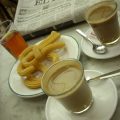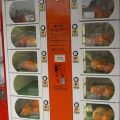Photo:Ivan FrolovThe cuisine of Morocco is able to surprise even the most sophisticated gourmet with its culinary masterpieces: slow-roasted lamb (so soft that it can be spread on bread like butter). Chicken with the aroma of olives and marinated lemons. Hummus - chickpeas mashed to a sour cream consistency with olive oil, herbs and lemon juice.
Eat hands
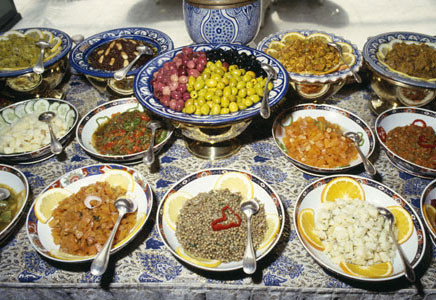 Moroccan cuisineI like Moroccan cookingMy American friend Karl, who had lived in this country for many years and once decided to surprise his friends, introduced us to this idea. When we came to his place for dinner, there was no cutlery on the table at all. "We'll eat with our hands," Karl announced. This did not cause much joy among the guests. Only the host's youngest daughter clapped her hands joyfully, anticipating a fun evening. At first, everyone was offered bowls filled with water and rose petals. They say that once at a diplomatic reception such a bowl was given to one of the Soviet leaders, and he drank it in one gulp. But most likely this is an old joke. Of course, rose water is quite suitable for drinking, but Moroccans serve it so that the guest can wash his hands, because he will have to eat with the thumb, index and middle fingers of his right hand. Even if you have been accustomed to a fork and knife since infancy, throw away traditional etiquette when sitting down at a Moroccan table. I promise you, eating with your hands is very pleasant. But we still couldn’t do without a spoon, because the first thing on the table was soup. Moroccans have a great variety of appetizers, but if you are invited to a dinner party, it will start with soup. We were served two at once - harira and chorba. The first is made from lamb with coriander and beans and traditionally marks the end of the Ramadan fast. Chorba is a spicy chicken broth. God knows how many spices the generous hand of our host poured into it. At the same time as the soup, baked lamb and pastilla (not to be confused with our sweet pastilla) were served to the table. Moroccan pastilla - a traditional dish for the most important events, such as welcoming a guest of honor. It is made from pigeon meat, hard-boiled eggs, and almonds, sandwiched between layers of very thin pastry. The dish is topped with a generous amount of powdered sugar, and sometimes cinnamon. It is said that the more layers of meat and pastry in a pastilla, the better the guest is treated.
Moroccan cuisineI like Moroccan cookingMy American friend Karl, who had lived in this country for many years and once decided to surprise his friends, introduced us to this idea. When we came to his place for dinner, there was no cutlery on the table at all. "We'll eat with our hands," Karl announced. This did not cause much joy among the guests. Only the host's youngest daughter clapped her hands joyfully, anticipating a fun evening. At first, everyone was offered bowls filled with water and rose petals. They say that once at a diplomatic reception such a bowl was given to one of the Soviet leaders, and he drank it in one gulp. But most likely this is an old joke. Of course, rose water is quite suitable for drinking, but Moroccans serve it so that the guest can wash his hands, because he will have to eat with the thumb, index and middle fingers of his right hand. Even if you have been accustomed to a fork and knife since infancy, throw away traditional etiquette when sitting down at a Moroccan table. I promise you, eating with your hands is very pleasant. But we still couldn’t do without a spoon, because the first thing on the table was soup. Moroccans have a great variety of appetizers, but if you are invited to a dinner party, it will start with soup. We were served two at once - harira and chorba. The first is made from lamb with coriander and beans and traditionally marks the end of the Ramadan fast. Chorba is a spicy chicken broth. God knows how many spices the generous hand of our host poured into it. At the same time as the soup, baked lamb and pastilla (not to be confused with our sweet pastilla) were served to the table. Moroccan pastilla - a traditional dish for the most important events, such as welcoming a guest of honor. It is made from pigeon meat, hard-boiled eggs, and almonds, sandwiched between layers of very thin pastry. The dish is topped with a generous amount of powdered sugar, and sometimes cinnamon. It is said that the more layers of meat and pastry in a pastilla, the better the guest is treated.
Gold groats
Naturally, there was also couscous.After all, in the Maghreb countries it is one of the main food products. This cereal (and the dish made from it) was invented by the Berbers, who were the first to cook it on the basis of semolina from durum wheat. Traditionally, couscous was made by women, since it is a very labor-intensive process, and therefore not for men. Although women in the East have not yet been completely liberated, the production of couscous is now mechanized. Semolina is sprinkled with water, then grains are formed from the resulting mass, which are then sprinkled with dry semolina or flour, after which they are sifted. Too small grains that pass through the sieve are sprinkled with semolina again, and so on ad infinitum. A smoking mountain of golden grains in the center– multi-colored slices of vegetables and pieces of meat. This is the great Moroccan dish. If you have inhaled its aroma at least once, you will remember it for the rest of your life. Like Morocco itself, which has combined many cultures and traditions, couscous combines many ingredients. It is always cooked on Friday, a holy day for Muslims, and is served to dear guests. It is served at funerals. But couscous is not cooked for a wedding or the birth of a child. Moroccans eat it with their hands, deftly making balls from cereals and mashed vegetables. This way, they say, it tastes better and there is no risk of getting burned. Traditionally, especially in villages, they wash it down with kefir. Couscous is cooked in a special saucepan (borma), in French le couscoussier, so it is easier to call it a couscous maker. A couscous maker consists of two detachable parts: a large tall saucepan and a colander that fits tightly into it. Couscous is steamed and served with stewed meat and/or vegetables. The meat is always stewed in large pieces and then divided into portions. A brilliant invention is semi-cooked couscous, which only requires pouring hot water over it. The classic version is to season the couscous with lemon juice and garnish with fresh mint leaves.
A smoking mountain of golden grains in the center– multi-colored slices of vegetables and pieces of meat. This is the great Moroccan dish. If you have inhaled its aroma at least once, you will remember it for the rest of your life. Like Morocco itself, which has combined many cultures and traditions, couscous combines many ingredients. It is always cooked on Friday, a holy day for Muslims, and is served to dear guests. It is served at funerals. But couscous is not cooked for a wedding or the birth of a child. Moroccans eat it with their hands, deftly making balls from cereals and mashed vegetables. This way, they say, it tastes better and there is no risk of getting burned. Traditionally, especially in villages, they wash it down with kefir. Couscous is cooked in a special saucepan (borma), in French le couscoussier, so it is easier to call it a couscous maker. A couscous maker consists of two detachable parts: a large tall saucepan and a colander that fits tightly into it. Couscous is steamed and served with stewed meat and/or vegetables. The meat is always stewed in large pieces and then divided into portions. A brilliant invention is semi-cooked couscous, which only requires pouring hot water over it. The classic version is to season the couscous with lemon juice and garnish with fresh mint leaves.
When I have time
To prepare Moroccan dishes you needa lot of time - this is their main drawback. But, as they say, hunting is worse than captivity. Free up a day, invite guests for the evening, go to the market and the supermarket - and get down to business. The main tool of Moroccan cooking istagine - a special clay container with a lid. Food cooked in a tagine has a unique, inimitable taste. That's why dishes are often named after this pot, for example, tagine with fish or tagine with lamb. Traditionally, tagine is cooked on coals, but at home you can make do with a gas stove. You need to cook for a long time, on low heat, placing a diffuser under the tagine - a metal plate with holes so that the food does not burn. Another important dish is a kasria, or simply a huge clay dish in which housewives knead dough for homemade bread and in which couscous is served. If you do not have couscous at home and you have not yet acquired your own tagine, I am ready to share a recipe for another delicious Moroccan dish that has delighted my friends more than once. When you cook it, don't tell them what it is, let them guess for themselves. Be patient - and get to work. First, we need saffron. Moroccans add this spice to almost all dishes. In order for saffron to give the dish aroma and color, it needs to be preheated, for example, in a dry frying pan (the fire is super small, don't burn it!), then let it "rest" for a few minutes. But I advise you to simply put the saffron stamens on the lid of the cauldron, which can easily replace the exotic tagine. Pour a generous pinch of heated saffron with a small amount of hot water, and let it wait for its time. In the meantime, take half a kilo of white fish fillet and cut it into pieces. In principle, you can use any fish, the main thing is that it is fresh and boneless. You will also need a few green onions, a bunch of parsley and cilantro, an egg and some dry bread crumbs. Put all of this in a blender, add the saffron water and mix well.
The main tool of Moroccan cooking istagine - a special clay container with a lid. Food cooked in a tagine has a unique, inimitable taste. That's why dishes are often named after this pot, for example, tagine with fish or tagine with lamb. Traditionally, tagine is cooked on coals, but at home you can make do with a gas stove. You need to cook for a long time, on low heat, placing a diffuser under the tagine - a metal plate with holes so that the food does not burn. Another important dish is a kasria, or simply a huge clay dish in which housewives knead dough for homemade bread and in which couscous is served. If you do not have couscous at home and you have not yet acquired your own tagine, I am ready to share a recipe for another delicious Moroccan dish that has delighted my friends more than once. When you cook it, don't tell them what it is, let them guess for themselves. Be patient - and get to work. First, we need saffron. Moroccans add this spice to almost all dishes. In order for saffron to give the dish aroma and color, it needs to be preheated, for example, in a dry frying pan (the fire is super small, don't burn it!), then let it "rest" for a few minutes. But I advise you to simply put the saffron stamens on the lid of the cauldron, which can easily replace the exotic tagine. Pour a generous pinch of heated saffron with a small amount of hot water, and let it wait for its time. In the meantime, take half a kilo of white fish fillet and cut it into pieces. In principle, you can use any fish, the main thing is that it is fresh and boneless. You will also need a few green onions, a bunch of parsley and cilantro, an egg and some dry bread crumbs. Put all of this in a blender, add the saffron water and mix well.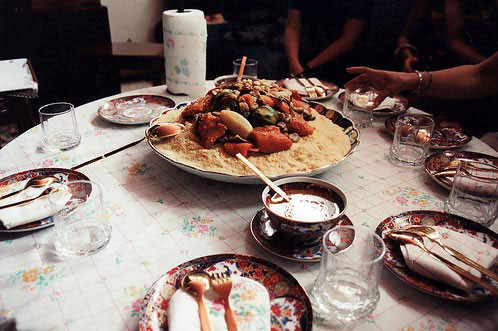 You will get airy minced meat.Form balls of any size out of it. I am guided by the saying that a big piece makes the mouth happy, so I make big ones. Put the balls in the refrigerator and make the sauce. First, you need good tomatoes without skin (it is very easy to remove the skin if you dip a tomato, pierced with a fork, into boiling water for a few seconds). Squeeze the seeds out of the tomatoes and chop coarsely. Fry the onion in olive oil in a cauldron or roaster until golden brown, then add whole cloves from one head of garlic. Now it's time for spices. Feel free to throw a teaspoon of sweet paprika, a knife tip of cayenne or any other hot pepper, cumin, ground coriander into the frying pan on the onion and garlic. Then after a minute put in the tomatoes, sugar, salt, sprinkle it all with black pepper and pour in a cup of water. Let it stew and turn into a sweet and sour sauce. If you like, add some lemon juice - it will be more sour; add more sugar - it will be sweeter. Now take the balls out of the refrigerator and put them in the cauldron. Let it stew again. The main thing is that it does not burn. Serve these balls (or meatballs - call them what you like) with fried potatoes, generously sprinkled with herbs. Radish salad with lemon juice will be a worthy addition to this dish. Moroccans are Muslims, and although they produce wine, they do not drink it. I will recommend a good bottle of Chablis. This way we will combine the incompatible - East and West.
You will get airy minced meat.Form balls of any size out of it. I am guided by the saying that a big piece makes the mouth happy, so I make big ones. Put the balls in the refrigerator and make the sauce. First, you need good tomatoes without skin (it is very easy to remove the skin if you dip a tomato, pierced with a fork, into boiling water for a few seconds). Squeeze the seeds out of the tomatoes and chop coarsely. Fry the onion in olive oil in a cauldron or roaster until golden brown, then add whole cloves from one head of garlic. Now it's time for spices. Feel free to throw a teaspoon of sweet paprika, a knife tip of cayenne or any other hot pepper, cumin, ground coriander into the frying pan on the onion and garlic. Then after a minute put in the tomatoes, sugar, salt, sprinkle it all with black pepper and pour in a cup of water. Let it stew and turn into a sweet and sour sauce. If you like, add some lemon juice - it will be more sour; add more sugar - it will be sweeter. Now take the balls out of the refrigerator and put them in the cauldron. Let it stew again. The main thing is that it does not burn. Serve these balls (or meatballs - call them what you like) with fried potatoes, generously sprinkled with herbs. Radish salad with lemon juice will be a worthy addition to this dish. Moroccans are Muslims, and although they produce wine, they do not drink it. I will recommend a good bottle of Chablis. This way we will combine the incompatible - East and West.
Tea is life
This is what one of my friends says - a big onetea connoisseur and lover. Green tea, prepared with fresh mint and lots of sugar, is served with dessert (seasonal fruits and sweet pies with fillings including honey, nuts, cinnamon, sesame and fennel seeds). It is a great way to improve digestion after a hearty meal. There is also a special Moroccan hit - orange tea. Everyone knows that Morocco is the country of oranges. Their flowers produce an incredibly fragrant water. This is what is added to tea. I have not seen it for sale in Russia, so if you want to try it, go to Morocco. You will not regret it.
Chicken Pastilla

- 4 servings
What do you need:
- 4 chicken legs
- 4 large onions
- 100 g butter
- 1 tbsp vegetable oil
- 1/2 l chicken broth
- 6 eggs plus 1 egg for greasing
- 100 g chopped almonds
- 8 sheets of filo dough
- a small bunch of parsley and cilantro
- 2 cinnamon sticks
- 1 tsp turmeric
- 1 tsp ground ginger
- 5 tsp powdered sugar
- 3 tsp ground cinnamon
- salt and pepper to taste
What to do:Fry whole chicken legs in vegetable and butter together with chopped onion, 3 minutes on each side. Add all the spices and finely chopped herbs, pour in the broth and 25-30 minutes. Remove the chicken, cool, separate the meat from the bones and cut into cubes. Pour lightly beaten eggs into the remaining broth and cook over low heat, stirring continuously, for about 30 minutes, until smooth. Throw the resulting sauce in a sieve to drain excess liquid, cool. Place the chicken fillet, egg sauce, sprinkle with cinnamon and sugar, and add almonds in the center of the first sheet of filo dough. Fold the edges of the dough, brush with egg, cover with the second sheet, turn over, and fold the edges. Let the pastille dry for 5-10 minutes, grease with vegetable oil, bake in the oven at 180 °C for 10 minutes. Before serving, sprinkle generously with powdered sugar and cinnamon.
Pancakes bagrir
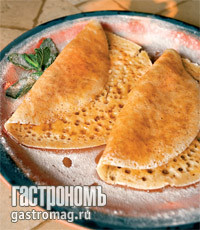
- 4 servings
What do you need:
- 250 g semolina
- 250 g flour
- 1 egg
- a pinch of salt and sugar
- 400 ml milk
- 1 packet (7 g) dry yeast
- powdered sugar and mint for decoration
For sauce:
- 4 tbsp honey
- 4 tsp butter
What to do:Mix all the ingredients for the pancakes with a mixer, add 1 cup of water. Put the dough in a warm place for 30 minutes. Bake the pancakes in a 20 cm frying pan. For the sauce, melt the butter and honey over low heat. Place two pancakes on each plate, grease with sauce, sprinkle with powdered sugar, garnish with fresh mint.






